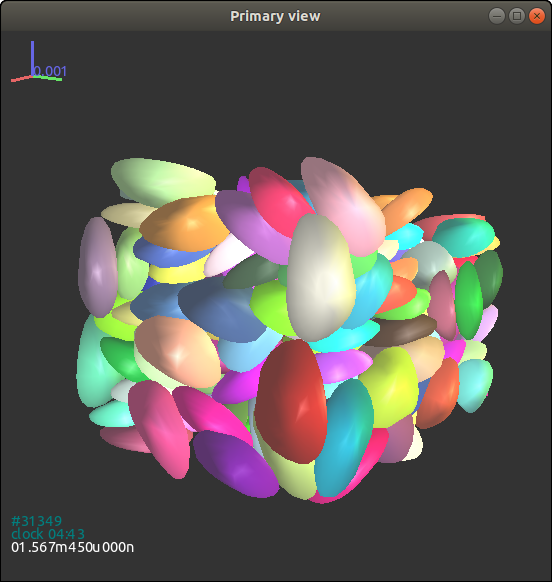Example 4: packing of poly-superellipsoids
Poly-superellipsoid has a capability of capturing major features (e.g., flatness, asymmetry, and angularity) of realistic particles such as sands in nature. A poly-superellipsoid is constructed by assembling eight pieces of superellipoids, governed by the following surface function at a local Cartesian coordinate system: $$\Big(\big|\frac{x}{r_{x}}\big|^{\frac{2}{\epsilon_{1}}} + \big|\frac{y}{r_{y}}\big|^{\frac{2}{\epsilon_{1}}}\Big)^{\frac{\epsilon_{1}}{\epsilon_{2}}} +\big |\frac{z}{r_{z}}\big|^{\frac{2}{\epsilon_{2}}} = 1$$ with
::: {.subequations} $$\begin{aligned} r_{x} = r_x^+ \quad{}\text{if}\quad{} x\geq 0 \quad{}\text{else}\quad{} r_x^- \label{appa} \ r_{y} = r_y^+ \quad{}\text{if}\quad{} y\geq 0 \quad{}\text{else}\quad{} r_y^- \label{appb} \ r_{z} = r_z^+ \quad{}\text{if}\quad{} z\geq 0 \quad{}\text{else}\quad{} r_z^- \label{appc}\end{aligned}$$ :::
where $r_x^+,r_y^+,r_z^+$ and $r_x^-,r_y^-,r_z^-$ are the principal elongation along positive and negative directions of x, y, z axes, respectively; $\epsilon_1, \epsilon_2$ control the squareness or blockiness of particle surface, and their possible values are in $(0,2)$ for convex shapes. Fig. 3.18{reference-type=“ref” reference=“figmultipolysuper”} intuitively shows how $\epsilon_1$ and $\epsilon_2$ affect particle surface. The module _superquadrics_utils provides two functions to generate a poly-superellipsoid (see Sec. 5.1.2{reference-type=“ref” reference=“modsuperquadrics”}):
-
NewPolySuperellipsoid(eps, rxyz, mat, rotate, isSphere, inertiaScale = 1.0)
-
NewPolySuperellipsoid_rot(eps, rxyz, mat, $q_w$, $q_x$, $q_y$, $q_z$, isSphere, inertiaScale = 1.0)
 Poly-superellipsoids with
$r_x^+=1.0, r_x^-=0.5, r_y^+=0.8, r_y^- = 0.9, r_z^+ = 0.4, r_z^- = 0.6$
and (a) $\epsilon_1=0.4, \epsilon_2=1.5$, (b)
$\epsilon_1=\epsilon_2=1.0$, (c)
$\epsilon_1=\epsilon_2=1.5$.
Poly-superellipsoids with
$r_x^+=1.0, r_x^-=0.5, r_y^+=0.8, r_y^- = 0.9, r_z^+ = 0.4, r_z^- = 0.6$
and (a) $\epsilon_1=0.4, \epsilon_2=1.5$, (b)
$\epsilon_1=\epsilon_2=1.0$, (c)
$\epsilon_1=\epsilon_2=1.5$.
Here we give an exemplified script for packing of poly-superellipsoids as follows:
|
|
After running the script above, the user is expected to see a packing as shown in Fig. 3.19{reference-type=“ref” reference=“figpolysuperpacking”}.
 {#figpolysuperpacking
width=“10cm”}
{#figpolysuperpacking
width=“10cm”}